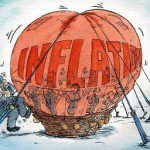Tuesday’s election upended not just the political consensus but also the market one. In the aftermath, one investment theme has dominated: reflation. Specifically, this suggests that after several years of fiscal austerity and several decades of declining inflation, these trends are on the cusp of reversing. If so, what does this mean for markets?
market one. In the aftermath, one investment theme has dominated: reflation. Specifically, this suggests that after several years of fiscal austerity and several decades of declining inflation, these trends are on the cusp of reversing. If so, what does this mean for markets?
The comments above and below are excerpts from an article by Russ Koesterich, CFA (BlackRockBlog.com) which may have been edited ([ ]) and abridged (…) by munKNEE.com (Your Key to Making Money!)
to provide a faster & easier read. Register to receive our bi-weekly Market Intelligence Report newsletter (see sample here , sign up in top right hand corner.)
Since the election, investors appear increasingly convinced that a Trump administration will lead to higher inflation, and potentially higher growth as well. By Thursday (10 November 2016) U.S. 10-year inflation expectations – based on break-evens in the TIPS market – had soared to 1.90%, the highest level since the summer of 2015.
Besides the impact of aggressive fiscal stimulus that President-elect Trump has proposed, inflation expectations are rising on the back of fundamental developments that preceded the election. After declining for 18 months, oil prices have been stable since the spring. More importantly, core inflation has been steadily creeping higher on the back of a sharp acceleration in medical costs and higher housing inflation. This is important as these components of inflation tend to be “stickier” and larger than energy prices.
In addition, wages are starting to rise: U.S. average hourly earnings have accelerated to 2.8% Y-o-Y from a prior level of 2.7% in September and, among the lesser-noticed results from Tuesday’s election, four states voted to raise the minimum wage.
Against the dry tinder of firming prices, we now have a potential match: a rare combination of fiscal stimulus and tax cuts. A historic election has redrawn long-cherished political positions, and investors are facing an unusual combination of deficit-financed stimulus, delivered through the mechanisms of higher government spending and lower corporate and marginal tax rates. This potential relaxation of fiscal constraints is significant, particularly when you consider that the economy, specifically the labor market, has less slack than at any point in the post-crisis period.
What does this mean for portfolios?
In a reflationary environment, bonds are likely to be a less effective hedge against equity risk. Instead, investors are likely to hold more cash as a mechanism to dampen equity volatility. On a more granular level, investors may want to focus on those segments of the market, notably cyclical companies that stand to benefit from an acceleration in nominal growth. These include financials, which should benefit from a steepening yield curve, but also segments of the consumer space and “old economy” companies in sectors such as industrials and energy.
Finally, higher nominal growth should translate into higher nominal interest rates, to the detriment of the so-called bond market proxies (equities that provide high dividends). This was already evident the day after the election. While the S&P 500 was up over 1% on the day, U.S. utility stocks lost over 3% while consumer staples fell more than 1%. Although both sectors are off substantially from their summer highs, they are still far from cheap. Large cap consumer staples stocks trade for over 5x book value, roughly twice the multiple of the broader market and the highest valuation of any sector. This makes them especially vulnerable in a rising rate environment.
Welcome to the new world.
What do you think? Have your say in the Comment Section below.
 munKNEE.com Your Key to Making Money
munKNEE.com Your Key to Making Money